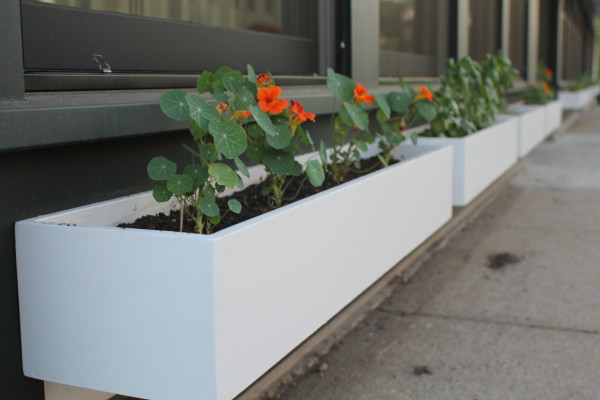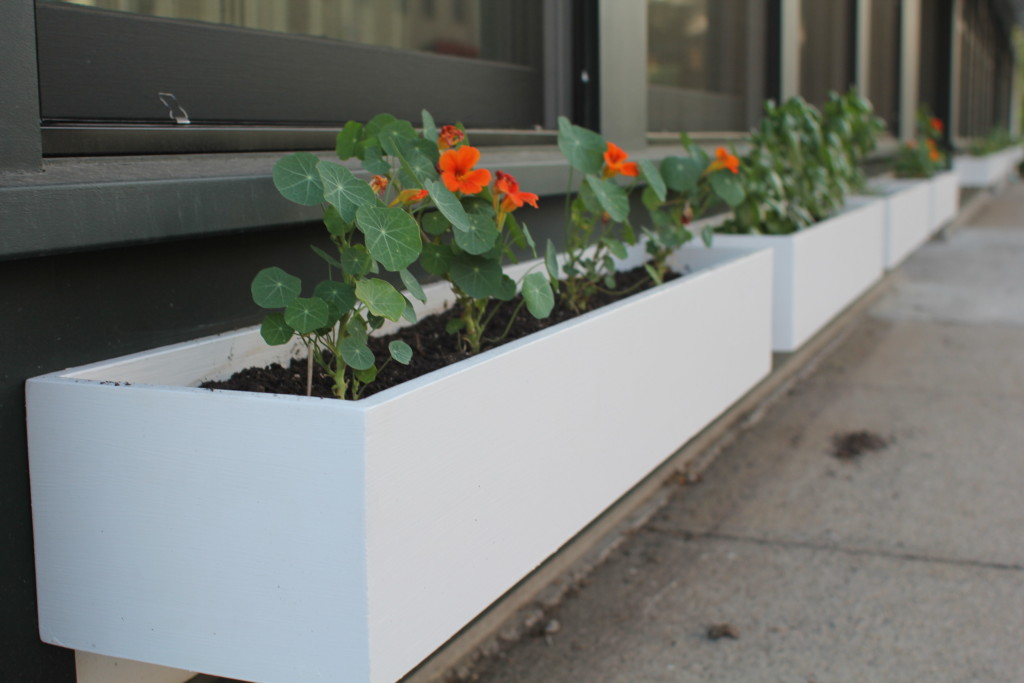

The use of window boxes dates as far back as the first century B.C in ancient Rome where they were used to keep small gardens for cooking herbs, medicinal herbs, and flowers for rituals and decoration.
Among the lower classes, in small villas where peasants had little gardening space, many people grew the plants they needed in window boxes.
Building Cedar Window Boxes
Window boxes can add an array of seasonal color and enhance the curb appeal of almost any structure. Window box gardening can be a fun and relaxing way to express your creativity or create a small garden in a cityscape.
This article will explain how to build a cedar window box and customize the dimensions to fit your desired window space.
Window boxes are relatively easy projects, we added some features to our design that some folks may or may not choose to do. Either way, the project requires only a few tools to complete.
What materials should the box be made of? How big should the box be? What size and depth is best for the plants that you want to pair with your home?
Let’s find out…
Choosing Materials:
We chose 1×8 Cedar to make our window boxes, mostly because the species is inherently insect and rot resistant. Additionally Cedar is light weight, paints well and has an attractive natural color if left unpainted.
Pine, Fir and Poplar simply do not last long in the elements, especially when you consider window boxes receive water almost daily.
Size and Depth:
Before purchasing your materials take time to determine how long your boxes will be. Generally speaking, window boxes are the same width or slightly smaller than the window they will be mounted under. Although I have seen folks use larger window boxes on windows with shutters.
You may also choose to go smaller and center it under the window. It really is up to you and your aesthetical eye and décor.
As far as height is concerned, you can follow a rule of thumb to size your box to 20 to 25 percent of the height of your window, for best symmetry.
Window boxes should be a minimum of 8 inches in depth and 8 inches from front to back to have enough room for a selection of plants. Larger is even better, particularly if you want to include a lot of plants and want them to fill out enough to overflow the box.
Bigger vs. Smaller Boxes:
Again, your choice as both have their advantages. Bigger hold more soil, and tend not to dry out as quickly, allowing you to plant perennial or more delicate plants. They also hold more plants allowing you to create layers of color.
Shallower boxes are lighter, easier to lift, do not overpower a home architectural features, and are better suited for drought-tolerant plants. Window boxes this size are an excellent choice for planting annuals, herbs and artificial plants
Measuring:
Once you’ve decided what types of plants you will use in the window boxes it’s time to measure your windows.
Measure the width of your window trim or window sill to get the window box length. Then measure the height and calculate the 20-25% rule of thumb. Sometimes using a visual aid such as a cardboard cutout taped in place can be useful determining size.
During this step you should be thinking about how you will mount your window box. There are several methods of mounting which include but are not limited to:
- Using structural screws
- Small lag bolts
- Combination of screws and brackets
- Window box holders
- French cleat hanger
French Cleat Hanging:
A French cleat is way of securing window boxes and involves using two “cleat” boards, each with an opposing 45 degree bevel. One cleat is mounted to the wall and the other to the window box.
Once the cleat is secured to the wall, the window box is lifted on to it.
TIP – If the wall cleat is left slightly shorter than the window box cleat, you will have some left or right adjustment, after it is hung, for perfect positioning. When measuring the dimensions of side panels, allow an extra overhang on back side panels to cover [hide] the French cleat.
Determine the Joinery:
Prior to building your boxes you need to think about how you will assemble your window box. Many simple boxes are simply constructed with butt joints and nails or screws.
You can choose this method or you can miter your corners to eliminate and hide the end grain. Mitering is a more finished carpentry look but should include some mechanical fastening in the form of biscuits or tenons. More on that below.
Cutting Materials:
If you’re lucky, all of your window boxes will be the same size and cutting will me a matter of production cutting repetitive size pieces.
For each window box you will need to cut two long parts, the exact length of the window bow, two side parts and a bottom. Each box has 5 parts to assemble plus your mounting preference.
Measure each 1-by-8-inch board twice, and mark the required lengths. Cut all required sections. If all of your window box parts are the same, consider setting up and using a stop block. Stop blocks allow you to make accurate, repetitive cuts time after time, eliminating the need to measure each piece of wood. This is crucial and saves time when many of the components need to be the exact same size.
Making the Bottom Panel:
Most people simply fasten the front, back and sides to the bottom panel, which is a fine way to build a window box.
On our project we used a dado cutter and cut 3/8-inch grooves in the front, back and two side panels. We choose to use a ½” pvc board as our bottom panel for longevity. The panel was routed with a rabbit router bit so that it fit into and floated inside the cedar panel grooves. We left 3/16 of expansion room on all sides for expansion and contraction of materials. We liked this approach, because there are no mechanical fasteners holding this bottom panel in, that can rust.
Assembling the Window Box:
If you’re assembling butt joints, simply assemble your front and back boards to the side pieces using galvanized or stainless steel 1/2-inch wood screws through the predrilled pilot holes. If you prefer you can use a counter sink and fill the holes later with cedar wood plugs. To do this you will need a counter sink and matching plug cutter. Plug cutters will work in power drill but I prefer to use a drill press.
On our window boxes we mitered the front two joints. We used biscuit cutter to cut matching biscuits in each piece of wood, inserted the biscuits, with waterproof glue and then clamped the boxes tight overnight. I also added some 16 gauge stainless steel nails to the mitered joints.
We used a tenon cutter to secure the back board to the two sides of our window box. Tenons are extremely strong and are used to join two mating mortises. These parts were also glued, clamped and nailed. All nail holes were later filled and sanded.
If you decided on using a French cleat this would be the time to install cleat to the box.
Drainage Holes:
We drilled 3/8-inch drainage holes in several places along bottom board of each window box. The number or pattern is up to you, but drill one hole roughly every six square inches, and give water plenty of room to escape.
Finishing:
We filled all nail holes, sanded and primed all exposed wood with a quality oil primer. The window boxes were finished with two coats of latex top paint.
Mounting:
As mentioned earlier there are several ways to mount a window box from fasteners, cleats or a pair of window box brackets.
The first method is direct mounting, where the back wall of the window box is pre-drilled holes and permanently secured in place with a fastener. The second is cleat mounting, where you attach a long, sturdy cleat to your wall and then hang the window flower box from the cleat. The advantage to using a cleat is you can easily lift the window box off for replanting or winter storage. The third is using brackets, which usually involve a combination of direct mounting and bracket support. This is a useful and many times needed method when the window box is larger and heavy.
The best choice will depend on the materials, design and construction of your window box and mounting needs of your house.
On our project we pre-drilled holes and mounted our window boxes and used 6-8 GRX structural screw fasteners. The GRX fasteners are weather resistant, have high quality case‐hardened steel with high tensile, torque and shear strength.
Planting:
Fill the window box with a 1- to 2-inch layer of gravel in the bottom of window box, to allow excess water to drain. Cover gravel with potting soil, filling box to about an inch from top.
We purchased plastic planters for our cedar window box rather than planting directly. If you do this you may want to buy the planters first to determine your window bow depth, width and length. The plastic liners we purchased were smaller than our window boxes.
The advantage of using plastic planters is so you can lift the planter out of the box to change soil or plants. This method is best for second story windows or any window too high to get to from the ground.
Conclusion:
From simple to ornate, traditional to contemporary, rustic to elegant, wood or terra cotta window box planters cover a large range or materials, styles that will fit your homes décor or your personal style.
Get planting!

